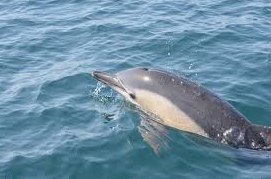
A dolphin, nicknamed Jo Jo by locals, was spotted swimming in west London before being found dead, along with another in Greenwich.
Two dolphins have been discovered dead along the River Thames, after being seen swimming through areas of west and south-east London. One of the dolphins, nicknamed Jo Jo by local children, had been spotted multiple times in the Thames around Hammersmith last Thursday. This sighting raised concerns due to its lethargic and disoriented behaviour.
Mary Tester, a volunteer from British Divers Marine Life Rescue (BDMLR), confirmed on Monday that two dead dolphins had been found in recent days. One was located in Battersea on Sunday, which is believed to be Jo Jo. Another dolphin was found at Greenwich, and both are thought to belong to the same pod of adult common dolphins.
Earlier, social media users reported seeing two dolphins “playing” in the water near Greenwich and Deptford Creek on Tuesday and Wednesday. The same dolphin, Jo Jo, was then observed swimming between Hammersmith and Wandsworth Park, with reports describing it as unusually sluggish.
While there have been reports of a third dead dolphin, its identity has yet to be confirmed, leaving some uncertainty about the total number of affected animals.
Ms Tester expressed concern over the growing frequency of dolphin sightings in the Thames, which is becoming a troubling trend with no established rescue protocol. She highlighted the difficulties of intervening when dolphins are spotted in the river, as there are legal complexities and a lack of permissions from river authorities for BDMLR to act.
The BDMLR currently has a team of 5,000 volunteers across the country who typically respond to strandings. However, encountering dolphins alive but stranded in the river presents unique challenges, and Ms Tester hopes for a clearer strategy to assist dolphins in distress.
There are plans to conduct post-mortems on the deceased dolphins to help determine the cause of their deaths, with possibilities including pollution, illness, or starvation. Ms Tester noted that while seeing dolphins in the Thames is exciting, it also serves as a “red flag” for the ecosystem’s health. Dolphins are not typically found this far up the river, and their presence often signals a larger environmental concern.
So far this year, five pods of dolphins have ventured beyond the estuary into the Thames, with three making it to London. Unfortunately, all three pods have not survived, and this latest case adds to the concerning trend.












